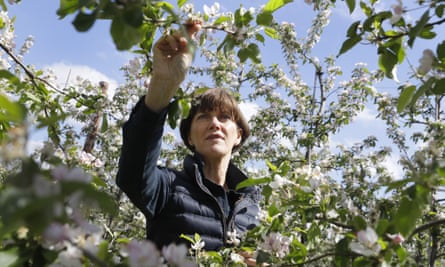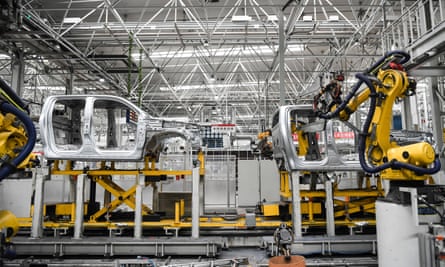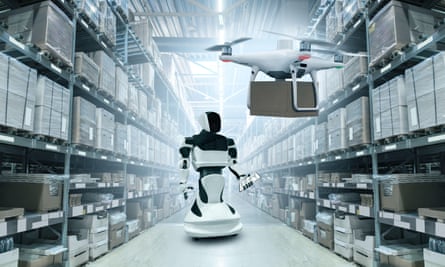
The high profile race to enhance their search products has underscored the importance of artificial intelligence to Google and Microsoft – and the rest of the economy, too. Two of the world’s largest tech companies announced plans for AI-enhanced search this month, ratcheting up a tussle for supremacy in the artificial intelligence space. However, the debut of Google’s new chatbot, Bard, was scuppered when an error appeared, knocking $163bn (£137bn) off the parent company Alphabet’s share price. The stock’s plunge showed how crucial investors think AI could be to Google’s future.
However, the increasing prominence of AI has implications for every corner of the economy. From retail to transport, here’s how AI promises to usher in a wave of change across industries.
Farming
Monitoring weather patterns, managing pests and disease, working out the need for extra irrigation, or even which crops to grow where: many farmers believe agriculture is fertile ground for artificial intelligence.
Many food producers are using AI to collect and analyse data in their efforts to improve productivity and profitability.
AI’s capacity for combining and analysing large datasets is already supplying farmers with real-time information on how to improve the health of their crops and increase yields. Drones and in-ground sensors can play a role in observing growing crops and soil conditions across hundreds of acres of land, including checking whether they need more water, fertiliser or herbicide and whether they are being affected by disease or destroyed by animals.
Ali Capper, who grows apples and hops at her family farm on the border of Herefordshire and Worcestershire, has invested in new technology, including automated orchard sprayers, to use alongside the digital soil mapping she has employed since 2017.
“Many agri-tech innovations will help us to be kinder to the farmed environment as well as more efficient and profitable,” Capper said.
In the face of labour shortages, especially acute since Brexit, farmers have long hoped that advances in robotics – “agribots” – will help to make sure crops get picked on time. A lack of workers led to £60m of food wasted in 2022 alone, according to the National Farmers’ Union.
While four-armed robots, designed for the delicate work of picking soft fruits, are being developed, robots with the dexterity of the human hand, capable of picking at speed without damaging fruit such as raspberries, may be a decade away from widespread use. Nonetheless, automation has already changed some of the most laborious jobs in farming, from drilling seeds to spraying and watering crops. Joanna Partridge
Media companies have embraced machine learning to boost subscriptions and advertising and to help make decisions about what stories to promote.
News organisations are hiring data scientists on six-figure salaries to pull together data to track customers and guide them towards particular products, while also providing workers with tools to take the grunt work out of finding and writing stories.
Lisa Gibbs, the director of news partnerships at the Associated Press, said in a London School of Economics study that her organisation could “find news faster and break news faster” with the aid of AI.
Media organisations are using data analysts to create targeted content that generates higher subscriptions and advertising revenues.
Jane Barrett, the global news editor in Reuters’ media strategy unit, told the LSE: “AI will help us get exactly the right content to the right person.” Phillip Inman
Energy
There are possible AI applications in every corner of the energy
industry: from predicting and identifying faults at power plants to
using weather forecasts to plan offshore windfarm projects.
With tight margins in a sector where almost 30 companies have gone bust during the energy crisis, retail energy suppliers are expected to increase the use of AI to cut down call times. Chatbots are used to ask basic questions before customers speak to a human adviser.
Ultimately, suppliers envisage AI will play a central role in future “smart grids”, allowing supply and demand to be more closely aligned, with a new generation of devices from smart meters and electric vehicles to solar panels and heat pumps able to improve efficiency. Jobs for engineers, meter readers and supply analysts are most under threat.
AI is also valuable to track carbon emissions. Boston Consulting Group has estimated that applying AI to multinational companies’ sustainability plans could be worth $1.3tn to $2.6tn through additional revenues and cost savings by 2030. Late last year, the government launched a £1.5m programme to study the use of AI to reduce the UK’s carbon emissions. Alex Lawson
Manufacturing
Manufacturing veterans know all too well how automation can sweep through an industry. In 2019, the UK’s Office for National Statistics said almost two-thirds of metalworking machine operatives were at risk.

Part of the automation drive is for efficiency. Machine learning algorithms are already being deployed on the burgeoning piles of data produced within big factories for “predictive maintenance” – replacing parts before they fail and potentially requiring fewer technicians.
But the rapid rise of generative artificial intelligence suggests it will not only be people on factory lines who will be affected. Generative AI is already being used to design products much more quickly, test them virtually as a “digital twin”, and manufacture them much more quickly. Combined with innovations such as 3D printing, this could lower development costs dramatically and would require fewer engineers in aerospace, automotive and consumer electronics.
One logical end is something like the Star Trek replicator, a bot that designs and makes whatever its user desires from a text prompt – without human involvement. Jasper Jolly
Government
Running the country means the government collects vast amounts of personal and business data, all of which could be plugged into artificial intelligence and machine learning systems to improve the efficiency of policymaking and delivery of services. Everything from bin collections, call centres and analysis of data to prioritise spending could be targeted for improvement. However, it is not without challenges and controversy – not least for how algorithms are held to account.
The former head of the civil service, Mark Sedwill, has said greater use of AI and automation will probably lead to a reduction in headcount.
Some councils are building computer models using personal data to help predict child abuse and intervene before it can happen, while Blackpool council is using AI-powered satellite images to help fix potholes.
after newsletter promotion
There is concern in government that AI systems can build in human biases, risking the perpetuation of stereotypes and discrimination. Meanwhile, relying on computer models has stoked fear in the past that some public priorities are overlooked, including investment in the north of England and green projects.
More use of AI could improve efficiency but authorities will need to carefully check its effects. As the postwar US president Harry Truman said: “When you have an efficient government, you have a dictatorship.” Richard Partington
Transport
Transport workers have stubbornly held on to their jobs since the first driverless trains were tested on the tube – a development that was met with “Robots take over” headlines six decades ago. However, they are still regarded as most vulnerable in the long term, according to a 2021 report by PwC for the business department forecasting that proportionately the biggest job losses in the next 20 years would come in the transport sector.
Nonetheless, drivers are far from expendable, and are demanding high salaries whether operating HGVs, buses or trains – even as the first autonomous buses are trialled in Scotland and Milton Keynes. Recent dreams of imminent robotaxis have yet to become widespread reality, and Uber says its London drivers earn £34 an hour. Pilotless planes are technically possible, although few might fancy them after Boeing’s software-led 737 Max disasters.

Transport for London uses AI to help traffic flow and forecast disruption, while train operators have used simulators or digital twins to check train paths, platforms and timetables. The Rail Safety and Standards Board is working with academics to use machine learning from high-resolution video to tackle leaves on the line. Similar AI and video projects in Australia could teach driverless trains to recognise a green light – or whether the movement on a remote track is an encroaching human or a nearby kangaroo.
But the next iterations of AI could be profoundly political, as the current rail dispute in Great Britain underlines. Network Rail is hoping to shed more than 1,000 jobs, arguing that automation could create a more efficient and safe inspection regime by using data to predict faults. Gwyn Topham
Financial services
The financial services sector is at greater risk of job losses from AI than other sectors, according to government forecasts, but experts say this is partly a matter of catch-up.
“Other industries have already made these cuts,” said Sarah Kocianski, an independent fintech consultant.
For example, banks and wealth managers will need fewer staff to onboard new clients as they automate more of their customer background checks and will rely more heavily on AI to detect and flag potential fraud and money-laundering risks.
They will also be able to feed new guidelines from regulators into those machine learning programmes, to flag any potential breaches or shortfalls in the company’s systems, rather than relying on humans to conduct an initial review.
But these systems will still require human oversight, not only to build and programme the technology but also to conduct additional checks and sort out more complex problems.
“A critical risk is that firms succumb to the temptation to trust AI to make smarter lending or insurance decisions without understanding the reasoning process, and over-rely on the AI system without properly stress-testing its fitness for purpose,” said Karishma Brahmbhatt, a data and technology lawyer at Allen & Overy.
Alongside booming demand for tech staff to build and monitor AI programmes, firms will be competing for higher-skilled staff who can do forensic work if they suspect fraud or error, or provide bespoke support to customers. “You need more tailored people but you need fewer people,” Kocianski said. Kalyeena Makortoff
Retail
Almost a third of retail jobs could be displaced by technology by 2030 compared with 2017 levels, as automated tills, warehouse robotics and AI-based planning tools affect the UK’s biggest employer.

The most obvious change to any shopper is the rise in the use of self-checkouts and self-scanning systems in supermarkets in the last five years. Change was supercharged by the pandemic when labour became more expensive and difficult to find while shoppers became wary of interactions with staff.
Analysts at the advisory firm McKinsey have predicted that the number of cashiers could almost halve between 2017 and 2030 as these technologies are rolled out. Bryan Roberts at the industry body IGD said the majority of sales in most UK supermarkets are now rung up on self-scanning or automated tills.
The rise of labour costs has also led non-food retailers to give the technology a go. The Japanese-owned clothing chain Uniqlo introduced a system linked to radio frequency identification tags a few years ago.
The next step is the checkout-free store, led by Amazon Fresh, where cameras and shelf sensors mean that shoppers’ purchases are automatically registered on an app on their phone enabling them to just walk out and pay later.
Technology doesn’t stop at the till. Retailers are experimenting with robotic or AI-powered systems to spot gaps on shelves – with Marks & Spencer trialling a system that uses fixed cameras. Others have experimented with Dalek-type machines that cruise up and down the aisles.
Electronic labels on shelves, so prices can be changed automatically from head office, alongside AI-led technology to guide buying decisions and more robotics to pick and pack products in warehouses will also affect thousands of jobs. Sarah Butler



